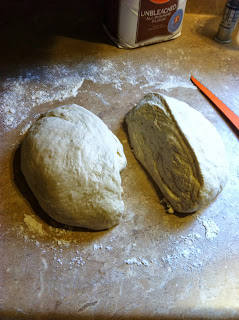From this...
To this, in just six easy steps!
Look at that. Just look at it. Isn't that something? Just flour, water and a little fruit juice is all that went into those. Everything else was just a little time and effort. That's about as simple as it gets... just like it's been done for centuries. That is the key to artisan bread. Made by hand, start to finish, by a single human being that honestly cares about his or her craft. It doesn't get much better than that.
The color and texture is close to perfect.
Crusty close-up.
These loaves in particular are some of the best I've made. The rise was perfect. The proof was perfect. The oven spring was just right. The vents were cut deep enough to get a good bloom as the crust set. The crumb is light and airy, not very open but the consistency is soft and spongy, like storebought bread, but without the preservatives.
*Drool*
Better view of the crumb.
To clarify, "crumb" is a term bakers use to define the inside of a loaf of bread. There are many things a skilled baker can tell by examining the crumb-- from the type of flour used to how wet the dough was before baking. Usually, I produce breads with a rather dense crumb, indicating a low-moisture dough. This time, however, I tweaked my usual formula by increasing the overall amount of water by about one cup. That in combination with a nice long autolyse (one hour) are likely the primary reasons this batch came out so well. Goes to show you (me too!) what good gluten formation can do for your bread.
Flavor-wise, the sour notes are a bit understated in these loaves. While still being very tasty, I think the flavor could have benefitted from a retarded proofing in the fridge instead of at room temperature prior to baking. Still very good bread by any definition, I'm quite proud of these.
Here's the breakdown:
Color - 9/10
Texture - 9/10
Crumb - 8/10
Flavor - 6/10
Aroma - 8/10
Out of a possible 50 points, this batch scores a 40 without breaking a sweat. Easily top-tier bread as far as my kitchen is concerned, and it seems to get a little better every time I make it.
That concludes my series on artisan sourdough. I hope you've enjoyed reading this as much as I've enjoyed writing it. Baking is a passion of mine, and it's a passion I like to share... because if I can do it, anyone can do it.
And I hope you do.
-Sherman




































